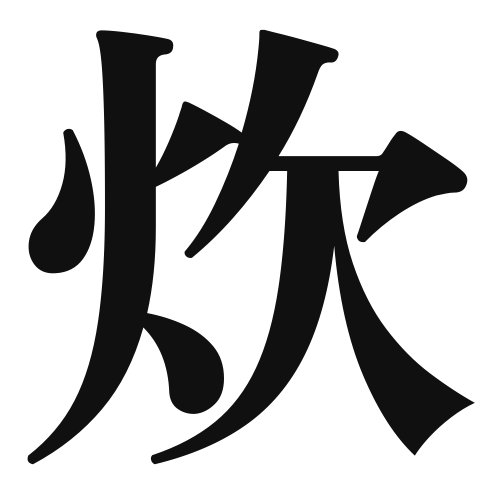1. Overview of Meaning
The kanji “炊” (sui) means “to cook” or “to boil,” particularly in reference to cooking rice. It is commonly used in the context of preparing meals and signifies the act of heating food with water.
2. Formation and Radical
Formation of the Kanji: The kanji “炊” is a phonetic-ideographic character (形声文字). It combines the radical for fire (火) with a phonetic component that suggests its pronunciation.
Radical: The radical of “炊” is 火 (hi), which means “fire.” This radical indicates that the character is related to heat or cooking.
3. Examples of Usage
Common Words and Phrases:
- 炊飯 (suihan) – cooking rice
- 炊き込みご飯 (takikomi gohan) – seasoned rice with various ingredients
Example Sentences in Daily Conversation:
- 今晩、炊飯器でご飯を炊きます。 (Konban, suihanki de gohan o takimasu.) – Tonight, I will cook rice in the rice cooker.
- このレシピは、炊き込みご飯の作り方です。 (Kono reshipi wa, takikomi gohan no tsukurikata desu.) – This recipe is for making seasoned rice.
4. Synonyms and Antonyms
Similar Kanji:
- 煮 (ni) – to boil or simmer, which refers to cooking food in water or broth.
- 焼 (yaki) – to grill or roast, which involves cooking food with dry heat.
Antonyms:
- 生 (nama) – raw, which refers to food that has not been cooked.
5. Cultural and Historical Background
Relation to Japanese Culture: Cooking rice is a fundamental aspect of Japanese cuisine, and the kanji “炊” reflects the importance of rice in Japanese culture. Rice is often considered a staple food and is central to many traditional meals.
Proverbs and Idioms:
- 「米は炊いてこそ美味しい」 (Kome wa taite koso oishii) – “Rice is delicious only when cooked.” This emphasizes the importance of proper cooking in achieving good flavor.
